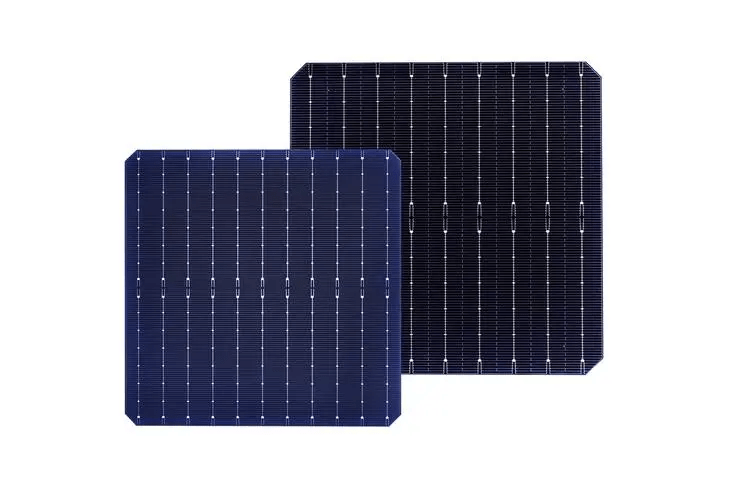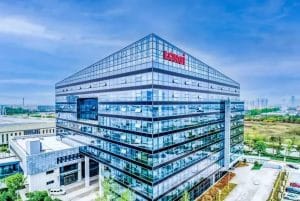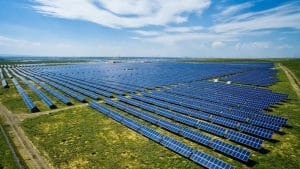(1) Overview of Perovskite Technology
Perovskite refers to a class of mineral compounds with an ABX3 structure, named after the Russian geologist Lev Perovski (e.g., CaTiO3). The perovskite materials with photovoltaic effects primarily consist of hybrid metal halide perovskites with the same crystal structure. Perovskite solar cells (PSC) are thin-film solar cells that use “organic-inorganic hybrid metal halides” as the photosensitive layer. Due to the similar crystal structure with perovskite composite oxides (CaTiO3) used, they are known as “perovskite solar cells.”
(2) Technological Developments
- Photovoltaic Conversion Efficiency
As of May 2024, the highest recorded efficiency for perovskite-crystalline silicon tandem solar cells is 33.9% (area: 1.0044 cm2) achieved by LONGi; for perovskite-crystalline silicon tandem modules, the record stands at 28.6% (area: 258.14 cm2) held by Oxford PV; for perovskite-perovskite tandem cells, the highest efficiency is 29.1% (area: 0.0489 cm2) maintained by Nanjing University and Renshine; for large-scale perovskite-perovskite tandem cells, the record is 28.2% (area: 1.038 cm2) also held by Nanjing University and Renshine; and for micro-modules of perovskite-perovskite tandem cells, the highest efficiency is 24.5% (area: 20.25 cm2) also maintained by Nanjing University and Renshine.
- Stability of Perovskite Solar Cells
The stability of commercial perovskite components has been significantly enhanced. In 2022, Hangzhou XFN 1.2m x 0.6m perovskite components received authoritative certification from the Association of German Electrical Engineers (VDE) and passed the full system stability tests of IEC61215 and IEC61730. In 2023, Jide Light 1.2m x 0.6m perovskite components obtained the first commercial certificate of IEC61215 and IEC61730 through rigorous certification by the German TUV Rheinland certification company.
In fact, in the research on the efficiency and stability of perovskite solar cells, researchers have not been able to simultaneously improve efficiency and stability. High efficiency does not necessarily mean high stability, and high stability cells do not guarantee high efficiency. In many cases, efficiency and stability cannot be balanced, hence the need to cooperatively improve the efficiency and stability of perovskite solar cells is a new challenge in the industry. In the industrialization process of perovskite photovoltaics, large-scale, mass-produced commercial perovskite components need to make new breakthroughs in the “stability-efficiency synergy” (simultaneously improving efficiency and stability).
Domestic Perovskite Industry Progress
Capacity is continuously expanding. As of the end of March 2024, domestic companies including XFN, Jinko Solar, and Jide Light have established three 100MW-level perovskite production lines. Ren Shuo Optoelectronics, Wandu Optoelectronics, Yao Energy Technology, and Mailuo Energy, four companies with 100MW-level perovskite pilot lines, have successively completed construction. In addition, many perovskite companies are building pilot lines and more laboratory-scale pilot lines have been established or are under construction. Longi Green Energy, JA Solar, Tongwei, Chint New Energy, Suntech, and ATS, among other crystalline silicon solar cell companies, have chosen the perovskite-crystalline silicon tandem solar cell route, leveraging the technical advantages of crystalline silicon solar cells to break through efficiency limitations. Listed companies such as CATL, BYD, and BOE are also venturing into the perovskite industry, focusing on related technologies and patent reserves.
Components are reaching commercialization thresholds. In 2023, perovskite photovoltaic standard components achieved a historic breakthrough, taking a significant step towards large-scale commercialization. XFN, Jinko Solar, and Jide Light have completed standard perovskite component projects. At the end of November, Three Gorges Group connected the 1MW perovskite solar power station in Ordos. These projects will accumulate valuable experience for the large-scale commercial application of perovskite standard components.
Continued new entrants. In June 2023, China Nuclear Power approved a proposal on the establishment of research and development projects for flexible and rigid commercial-grade perovskite pilot production lines, accelerating the industrialization of perovskite solar cells in 2023. In November 2023, leading display panel company BOE initiated a perovskite photovoltaic project, officially entering the photovoltaic industry. In the investor relations event in November 2023, BYD mentioned actively deploying perovskite battery technology.
Continued favor from the capital market. Despite the macro market environment, perovskite photovoltaic companies continue to be favored by the capital market, with at least 7 perovskite companies completing a new round of equity financing in 2023.
(IV) Main Issues
1. Stability of Products and Commercialization to be Verified
The stability of perovskite to be verified is a concern across various fields. Early perovskite devices had poor stability, but significant improvements have been made in recent years. The academic sector has a deep understanding of the factors influencing perovskite stability and has proposed various solutions. However, these solutions require more experimentation for validation. In terms of engineering, implementing the academic solutions into practice requires considerable secondary development work. Leading companies will start collecting field data on perovskite power stations in 2023, with more field data expected to validate perovskite product stability by 2024-2025.
2. Immature Development of Industrial Ecosystem
The production of perovskite components requires sophisticated specialized equipment. Currently, the equipment used for large-scale perovskite component preparation is transplanted from other fields and has not yet fully integrated with perovskite-related manufacturing technology. In the future, mature specialized equipment should be developed based on the materials and process technology involved in perovskite production.
3. Efficiency Testing and Power Calibration of Perovskite
Firstly, international certification bodies restrict the area definitions for photovoltaic cell (module) testing to only three types: total area, aperture area, and limited radiation area. Total area and aperture area are generally used in the testing of mature commercial components. However, perovskite efficiency certification commonly uses the limited radiation area method for cell and module testing. Nonetheless, many third-party certification bodies in the industry still use the “dead zone” method, resulting in deviations in test results and application effects due to different dead area proportions of the components.
Secondly, two international authoritative charts only recognize the so-called “steady-state efficiency,” which is very complex to test and cannot be widely used on production lines; the most commonly used power detection method in the photovoltaic industry, the “IV scanning method,” is overly sensitive to measurement conditions (scanning direction, scanning speed, etc.) when applied to perovskite components, leading to significant challenges in accurate power calibration. Therefore, academia, industry, and equipment providers need to jointly establish a reliable and efficient standard for electrical parameter testing of components.
Thirdly, the low-light performance and temperature coefficient of perovskite components are superior to crystalline silicon. Perovskite components generate more electricity than silicon under the same conditions. Testing perovskite components according to the original silicon component testing standards can lead to significant errors in test results. Therefore, establishing a new set of standards to label the power of perovskite components is crucial.
4. Collaborative Improvement of Efficiency and Stability in Mass-Produced Components
As the component area increases, the photoelectric conversion efficiency significantly decreases, and these highly efficient cells and components generally cannot guarantee their stability. The production of large-area perovskite components that simultaneously possess high efficiency and stability, referred to as “stabileffective synergy,” is a widely discussed issue across various fields and a key issue for the industrialization of perovskite.




